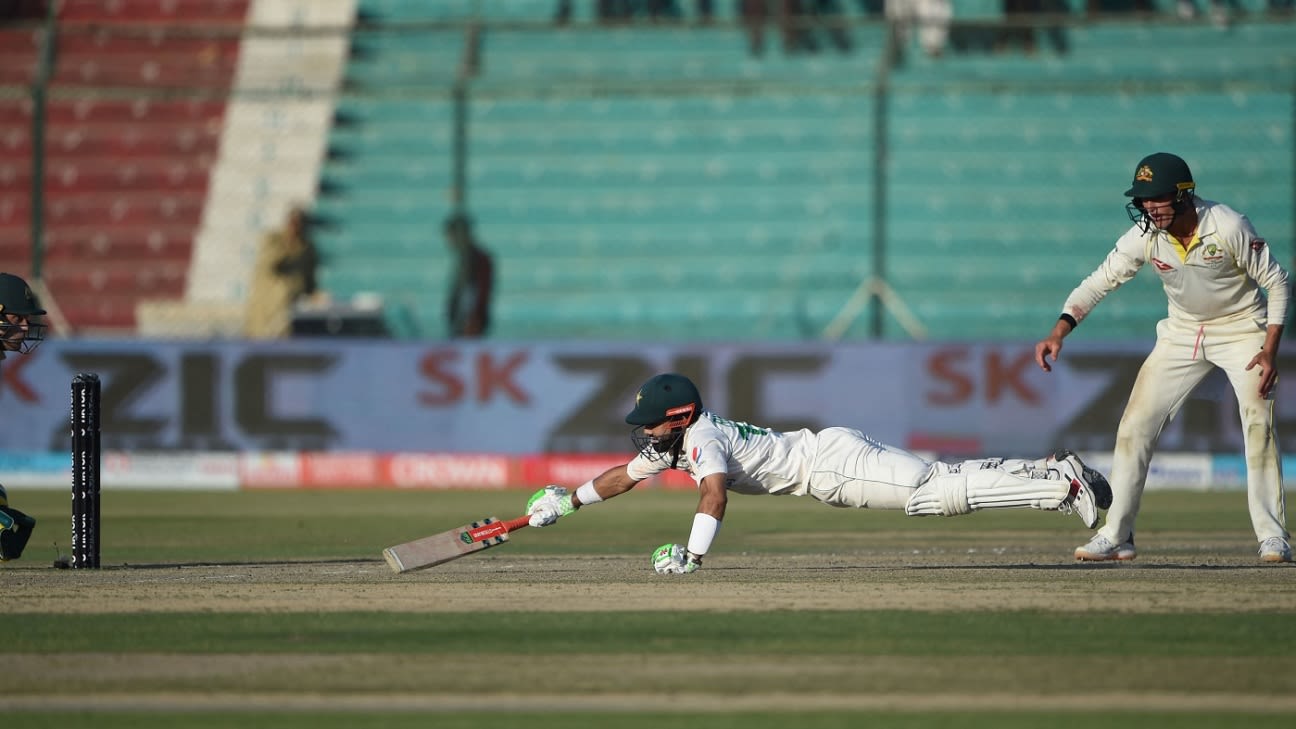Captain hails Swepson despite the debutant legspinner going wicketless and conceding 156 in the fourth innings
Not for the first time in recent memory, Australia were left to rue missed chances on the fifth day of a Test that they had controlled throughout but were unable to take victory from.
But Steven Smith’s drop off Abdullah Shafique on the fourth afternoon, which would have left Pakistan 38 for 3 against a still reasonably hard ball that was starting to reverse, then Usman Khawaja’s spill off Mohammad Rizwan late in the game, which would have left 18 balls for a last dart at the remaining two wickets, were the most clear-cut chances.
It followed a trend from the last two Tests Australia have played at the SCG – against India and England – when dropped catches have proved costly on the final day with the opposition surviving on both occasions. In all, this is the fifth fourth-innings scenario since 2019 where Australia were favourites to win but unable to take the game if the Ashes at Headingley and India’s famous chase at the Gabba are included.
“I walked off the field at the end of the day’s play without feeling there was something I hadn’t tried, or there wasn’t a plan we hadn’t given a really good chance at. In foreign conditions we are showing that we are able to adapt and play well over here. But of course, getting so close, [being] so far ahead of the game, and not coming away with the result can feel like it’s a missed opportunity.”
The late Khawaja drop at short cover meant that Swepson finished with figures of 0 for 156 in the second innings from 53.4 overs, but Cummins was delighted with his debut. Fellow spinner Nathan Lyon, who had struck in his first over of the second innings, threatened to steal the game late on with three wickets early in the final hour as Australia’s first frontline spin duo since 2018 sent down 108 overs between them.
“I thought Swepo bowled fantastically today,” Cummins said. “I don’t know how he’s ended up with those figures. Especially that middle session, he had an umpire’s call, a couple of half chances dropped off his bowling, lots of plays and misses. The way he was able to be a real wicket-taking option on a really good wicket without really footmarks to the right handers I was just really impressed with how he went about it.
“Nathan, I thought he bowled well, particularly today. Felt like he was going to get a wicket every over. When I took off him to bowl Starcy or myself, it was a hard decision to make because felt like he was so close to a wicket all day.”
The reverse-swing which had cut a swathe through Pakistan on the third day did not make such a dramatic appearance over the last two days, but Cummins said that was the difference between having new and set batters at the crease.
“Reverse-swing bowling can have a really big factor on the game, especially if you get a breakthrough, get a new batter in and they’ve got to start against a reversing ball things can move really quickly,” he said. “If that doesn’t happen, reverse-swing is still useful but it’s not all it’s cracked up to be.”
Cummins made some big tactical calls during the match, including extending Australia’s first innings into the third morning and then not enforcing the follow-on with a lead of 408. When they had Pakistan 21 for 2 second time around everything was slotting into place, but it took them almost 87 overs to claim their third wicket before being halted again as Babar Azam and Rizwan stayed together for 41.
“Overall I wouldn’t change too much to do honest,” he said. “Batting into day three gave us that chance to really have a crack at them – probably went better than we could have expected – but over here the wickets are pretty good. We tried to bat two-and-a-half days on the best time of the wicket, hoping that it would break up on day four and five and it held together pretty well.
“Babar, Rizwan, Shafique, thought they all batted fantastically the last two days. We knew the wicket wasn’t playing too many tricks but they batted superbly and made it really hard to get that breakthrough and when we did the next guy stuck at it as well.
“The good thing is it’s nil-all, we didn’t lose anything. Coming over here in these conditions, at the start of the series if you’d said it was going to be nil-all after two games you’d probably take that.”
Andrew McGlashan is a deputy editor at ESPNcricinfo
